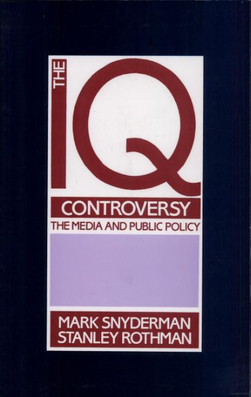The Black Intelligence Test of Cultural Homogeneity, also known as BITCH-100 or The BITCH Test, is an intelligence test created by Robert Williams in 1972 oriented toward the language, attitudes, and life-styles of African Americans.
The test consisted of a multiple-choice questionnaire in which the examinee was asked to identify the meaning of 100 words as they were then used in black ghettos. [1] Examples of words used included alley apple, black draught, blood, boogie jugie, and boot. [1]
The original sample used in the experiment consisted of 100 white and 100 black St. Louis high school students, aged 16–18 years old – half of them being from low socioeconomic levels and the other half from middle income levels. Williams also had data from two other samples of blacks and whites. These samples included 25 black and 13 white college students from Mississippi and 19 white graduate students from Boston University. Out of the 200 students who participated in the original sample the 100 black students answered 87/100 answers correctly and the whites answered 51/100 questions correctly. In the other samples the results were similar with the black students' scores being drastically different from those of the whites. [2] [3]
The results of the test showed that the black group performed much better than the white group. White students performed more poorly on this test than blacks, suggesting that there are important dissimilarities in the cultural backgrounds of blacks and whites. The results of these tests and examination of the BITCH-100 confirmed Robert Williams' belief that his intelligence test dealt with content material that was familiar to blacks. However, there exists a restriction of range in the current form of the test thereby limiting its usefulness as an instrument used for selection. [3] [2] [4] Some argue that these findings indicate that test bias plays a role in producing the gaps in IQ test scores. [5]
Both of these tests demonstrate how cultural content on intelligence tests may lead to culturally biased score results. Still, these criticisms of cultural content may not apply to "culture free" tests of intelligence. The BITCH-100 and the Chitling test both have explicit cultural assumptions, while normal standardized tests are only hypothesized to have implicit bias.[ by whom? ] The fact that a test can have bias does not necessarily prove that a specific test does have bias. However, even on cultural free tests, test bias may play a role since, due to their cultural backgrounds, some test takers do not have the familiarity with the language and culture of the psychological and educational tests that is implicitly assumed in the assessment procedure. [6]

Arthur Robert Jensen was an American psychologist and writer. He was a professor of educational psychology at the University of California, Berkeley. Jensen was known for his work in psychometrics and differential psychology, the study of how and why individuals differ behaviorally from one another.
The Flynn effect is the substantial and long-sustained increase in both fluid and crystallized intelligence test scores that were measured in many parts of the world over the 20th century, named after researcher James Flynn (1934–2020). When intelligence quotient (IQ) tests are initially standardized using a sample of test-takers, by convention the average of the test results is set to 100 and their standard deviation is set to 15 or 16 IQ points. When IQ tests are revised, they are again standardized using a new sample of test-takers, usually born more recently than the first; the average result is set to 100. When the new test subjects take the older tests, in almost every case their average scores are significantly above 100.

An intelligence quotient (IQ) is a total score derived from a set of standardised tests or subtests designed to assess human intelligence. The abbreviation "IQ" was coined by the psychologist William Stern for the German term Intelligenzquotient, his term for a scoring method for intelligence tests at University of Breslau he advocated in a 1912 book.
Discussions of race and intelligence – specifically regarding claims of differences in intelligence along racial lines – have appeared in both popular science and academic research since the modern concept of race was first introduced. With the inception of IQ testing in the early 20th century, differences in average test performance between racial groups were observed, though these differences have fluctuated and in many cases steadily decreased over time. Complicating the issue, modern science has concluded that race is a socially constructed phenomenon rather than a biological reality, and there exist various conflicting definitions of intelligence. In particular, the validity of IQ testing as a metric for human intelligence is disputed. Today, the scientific consensus is that genetics does not explain differences in IQ test performance between groups, and that observed differences are environmental in origin.
Cultural bias is the interpretation and judgment of phenomena by the standards of one's own culture. It is sometimes considered a problem central to social and human sciences, such as economics, psychology, anthropology, and sociology. Some practitioners of these fields have attempted to develop methods and theories to compensate for or eliminate cultural bias.
The g factor is a construct developed in psychometric investigations of cognitive abilities and human intelligence. It is a variable that summarizes positive correlations among different cognitive tasks, reflecting the fact that an individual's performance on one type of cognitive task tends to be comparable to that person's performance on other kinds of cognitive tasks. The g factor typically accounts for 40 to 50 percent of the between-individual performance differences on a given cognitive test, and composite scores based on many tests are frequently regarded as estimates of individuals' standing on the g factor. The terms IQ, general intelligence, general cognitive ability, general mental ability, and simply intelligence are often used interchangeably to refer to this common core shared by cognitive tests. However, the g factor itself is a mathematical construct indicating the level of observed correlation between cognitive tasks. The measured value of this construct depends on the cognitive tasks that are used, and little is known about the underlying causes of the observed correlations.
Intellectual giftedness is an intellectual ability significantly higher than average. It is a characteristic of children, variously defined, that motivates differences in school programming. It is thought to persist as a trait into adult life, with various consequences studied in longitudinal studies of giftedness over the last century. There is no generally agreed definition of giftedness for either children or adults, but most school placement decisions and most longitudinal studies over the course of individual lives have followed people with IQs in the top 2.5 percent of the population—that is, IQs above 130. Definitions of giftedness also vary across cultures.
The Wechsler Adult Intelligence Scale (WAIS) is an IQ test designed to measure intelligence and cognitive ability in adults and older adolescents.
The implicit-association test (IAT) is an assessment intended to detect subconscious associations between mental representations of objects (concepts) in memory. Its best-known application is the assessment of implicit stereotypes held by test subjects, such as associations between particular racial categories and stereotypes about those groups. The test has been applied to a variety of belief associations, such as those involving racial groups, gender, sexuality, age, and religion but also the self-esteem, political views, and predictions of the test taker. The implicit-association test is the subject of significant academic and popular debate regarding its validity, reliability, and usefulness in assessing implicit bias.

"Mainstream Science on Intelligence" was a public statement issued by a group of researchers led by psychologist Linda Gottfredson. It was published originally in The Wall Street Journal on December 13, 1994, as a response to criticism of the book The Bell Curve by Richard Herrnstein and Charles Murray, which appeared earlier the same year. The statement defended Herrnstein and Murray's controversial claims about race and intelligence, including the claim that average intelligence quotient (IQ) differences between racial and ethnic groups may be at least partly genetic in origin. This view is now considered discredited by mainstream science.
Intelligence: Knowns and Unknowns is a report about scientific findings on human intelligence, issued in 1995 by a task force created by the Board of Scientific Affairs of the American Psychological Association (APA) following the publication of The Bell Curve and the scholarly debate that followed it. The report was subsequently published in the February 1996 issue of the peer-reviewed journal American Psychologist.

The IQ Controversy, the Media and Public Policy is a book published by Smith College professor emeritus Stanley Rothman and Harvard researcher Mark Snyderman in 1988. Claiming to document liberal bias in media coverage of scientific findings regarding intelligence quotient (IQ), the book builds on a survey of the opinions of hundreds of North American psychologists, sociologists and educationalists conducted by the authors in 1984. The book also includes an analysis of the reporting on intelligence testing by the press and television in the US for the period 1969–1983, as well as an opinion poll of 207 journalists and 86 science editors about IQ testing.
Frank C. J. McGurk (1910–1995) was an American psychologist who was noted for his claims about race and intelligence. McGurk taught at Lehigh University, Villanova University, West Point, and Alabama College.

IQ classification is the practice of categorizing human intelligence, as measured by intelligence quotient (IQ) tests, into categories such as "superior" or "average".
Aversive racism is a social scientific theory proposed by Samuel L. Gaertner & John F. Dovidio (1986), according to which negative evaluations of racial/ethnic minorities are realized by a persistent avoidance of interaction with other racial and ethnic groups. As opposed to traditional, overt racism, which is characterized by overt hatred for and discrimination against racial/ethnic minorities, aversive racism is characterized by more complex, ambivalent expressions and attitudes nonetheless with prejudicial views towards other races. Aversive racism arises from unconscious personal beliefs taught during childhood. Subtle racist behaviors are usually targeted towards African Americans. Workplace discrimination is one of the best examples of aversive racism. Biased beliefs on how minorities act and think affect how individuals interact with minority members.
Robert Lee Williams II was a professor emeritus of psychology and African and Afro-American studies at the Washington University in St. Louis and a prominent figure in the history of African-American Psychology. He founded the department of Black Studies at Washington University and served as its first director, developing a curriculum that would serve as a model throughout the country. Williams was well known as a stalwart critic of racial and cultural biases in IQ testing, coining the word "Ebonics" in 1973 and developing the Black Intelligence Test of Cultural Homogeneity. He published more than sixty professional articles and several books. He was a founding member of the Association of Black Psychologists and served as its second president.
Herman George Canady was an American social psychologist. Canady, who was black, was the first psychologist to examine the role of the race of the examiner as a bias factor in IQ testing.
The relationship between nations and IQ is a controversial area of study concerning differences between nations in average intelligence test scores, their possible causes, and their correlation with measures of social well-being and economic prosperity.

Bias in Mental Testing is a book by Arthur Jensen about bias in IQ tests.
Originally named the Dove Counterbalance General Intelligence Test, the Chitling Test Created by Adrian Dove State employment officer at the Watts State Employment Service office in Watts, California (1966). Published in Jet magazine Feb. 9 1967 it was designed to demonstrate differences in understanding and culture between races, specifically between African Americans and Whites. There have been no studies demonstrating if the Chitling Test has validity in determining how streetwise someone is. Furthermore, the Chitling Test has only proved valid as far as face validity is concerned; no evidence has been brought to light on the Chitling predicting performance.